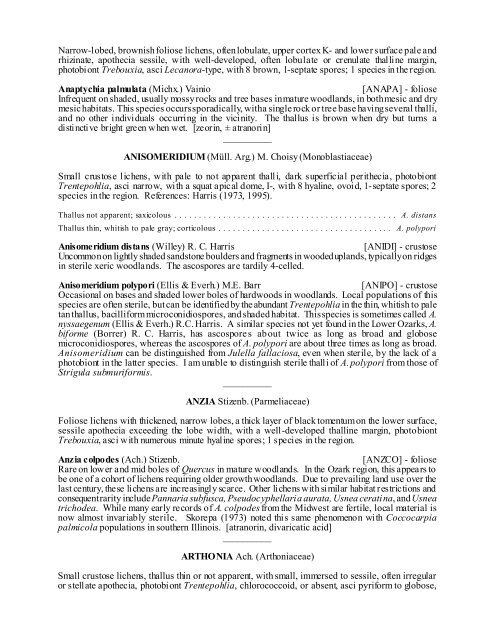lichens of the lower ozark region of missouri and arkansas
lichens of the lower ozark region of missouri and arkansas
lichens of the lower ozark region of missouri and arkansas
You also want an ePaper? Increase the reach of your titles
YUMPU automatically turns print PDFs into web optimized ePapers that Google loves.
Narrow-lobed, brownish foliose <strong>lichens</strong>, <strong>of</strong>ten lobulate, upper cortex K- <strong>and</strong> <strong>lower</strong> surface pale <strong>and</strong><br />
rhizinate, apo<strong>the</strong>cia sessile, with well-developed, <strong>of</strong>ten lobulate or crenulate thal line margin,<br />
photobiont Trebouxia, asci Lecanora-type, with 8 brown, 1-septate spores; 1 species in <strong>the</strong> <strong>region</strong>.<br />
Anaptychia palmulata (Michx.) Vainio [ANAPA] - foliose<br />
Infrequent on shaded, usually mossy rocks <strong>and</strong> tree bases in mature woodl<strong>and</strong>s, in both mesic <strong>and</strong> dry<br />
mesic habitats. This species occurs sporadically, with a single rock or tree base having several thalli,<br />
<strong>and</strong> no o<strong>the</strong>r individuals occurring in <strong>the</strong> vicinity. The thallus is brown when dry but turns a<br />
disti ncti ve bright green when wet. [zeorin, ± atranorin]<br />
__________<br />
ANISOMERIDIUM (Müll. Arg.) M. Choisy (Monoblastiaceae)<br />
Small crustose <strong>lichens</strong>, with pale to not apparent thalli, dark superficial peri<strong>the</strong>cia, photobiont<br />
Trentepohlia, asci narrow, wi th a squat apical dome, I-, with 8 hyaline, ovoid, 1-septate spores; 2<br />
species in <strong>the</strong> <strong>region</strong>. References: Harris (1973, 1995).<br />
Thallus not apparent; saxicolous .............................................. A. distans<br />
Thallus thin, whitish to pale gray; corticolous .................................... A. polypori<br />
Anisomeridium distans (Willey) R. C. Harris [ANIDI] - crustose<br />
Uncommon on lightly shaded s<strong>and</strong>stone boulders <strong>and</strong> fragments in wooded upl<strong>and</strong>s, typically on ridges<br />
in sterile xeric woodl<strong>and</strong>s. The ascospores are tardily 4-celled.<br />
Anisomeridium polypori (Ellis & Everh.) M.E. Barr [ANIPO] - crustose<br />
Occasional on bases <strong>and</strong> shaded <strong>lower</strong> boles <strong>of</strong> hardwoods in woodl<strong>and</strong>s. Local populations <strong>of</strong> this<br />
species are <strong>of</strong>ten sterile, but can be identified by <strong>the</strong> abundant Trentepohlia in <strong>the</strong> thin, whitish to pale<br />
tan thallus, bacilliform microconidiospores, <strong>and</strong> shaded habitat. This species is sometimes called A.<br />
nyssaegenum (Ellis & Everh.) R.C. Harris. A similar species not yet found in <strong>the</strong> Lower Ozarks, A.<br />
biforme (Borrer) R. C. Harris, has ascospores about twice as long as broad <strong>and</strong> globose<br />
microconidiospores, whereas <strong>the</strong> ascospores <strong>of</strong> A. polypori are about three times as long as broad.<br />
Anisomeridium can be distinguished from Julella fallaciosa, even when sterile, by <strong>the</strong> lack <strong>of</strong> a<br />
photobiont in <strong>the</strong> latter species. I am unable to distinguish sterile thalli <strong>of</strong> A. polypori from those <strong>of</strong><br />
Strigula submuriformis.<br />
__________<br />
ANZIA Stizenb. (Parmeliaceae)<br />
Foliose <strong>lichens</strong> with thickened, narrow lobes, a thick layer <strong>of</strong> black tomentum on <strong>the</strong> <strong>lower</strong> surface,<br />
sessile apo<strong>the</strong>cia exceeding <strong>the</strong> lobe width, with a well-developed thalline margin, photobiont<br />
Trebouxia, asci w ith numerous minute hyaline spores; 1 species in <strong>the</strong> <strong>region</strong>.<br />
Anzia colpodes (Ach.) Stizenb. [ANZCO] - foliose<br />
Rare on <strong>lower</strong> <strong>and</strong> mid boles <strong>of</strong> Quercus in mature woodl<strong>and</strong>s. In <strong>the</strong> Ozark <strong>region</strong>, this appears to<br />
be one <strong>of</strong> a cohort <strong>of</strong> <strong>lichens</strong> requiring older growth woodl<strong>and</strong>s. Due to prevailing l<strong>and</strong> use over <strong>the</strong><br />
last century, <strong>the</strong>se <strong>lichens</strong> are increasingly scarce. O<strong>the</strong>r <strong>lichens</strong> with similar habitat restrictions <strong>and</strong><br />
consequent rarity include Pannaria subfusca, Pseudocyphellaria aurata, Usnea ceratina, <strong>and</strong> Usnea<br />
trichodea. While many early records <strong>of</strong> A. colpodes from <strong>the</strong> Midwest are fertile, local material is<br />
now almost invariably sterile. Skorepa (1973) noted this same phenomenon with Coccocarpia<br />
palmicola populations in sou<strong>the</strong>rn Illinois. [atranorin, divaricatic acid]<br />
__________<br />
ARTHONIA Ach. (Arthoniaceae)<br />
Small crustose <strong>lichens</strong>, thallus thin or not apparent, with small, immersed to sessile, <strong>of</strong>ten irregular<br />
or stellate apo<strong>the</strong>cia, photobiont Trentepohlia, chlorococcoid, or absent, asci pyriform to globose,


